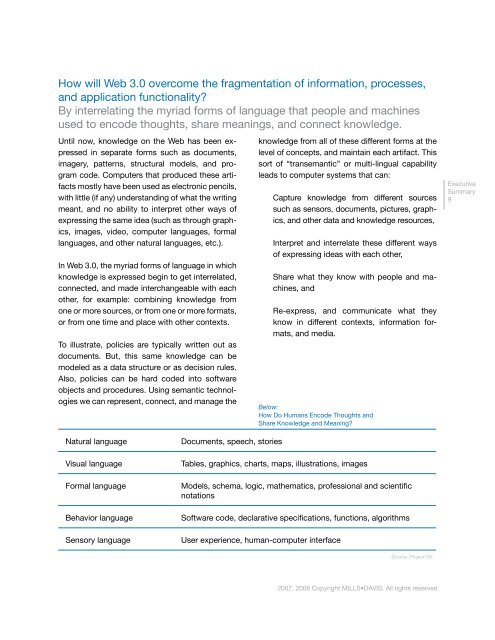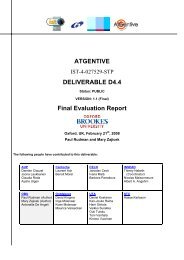Industry Roadmap to Web 3.0 & Multibillion Dollar ... - INSEAD CALT
Industry Roadmap to Web 3.0 & Multibillion Dollar ... - INSEAD CALT
Industry Roadmap to Web 3.0 & Multibillion Dollar ... - INSEAD CALT
You also want an ePaper? Increase the reach of your titles
YUMPU automatically turns print PDFs into web optimized ePapers that Google loves.
How will <strong>Web</strong> <strong>3.0</strong> overcome the fragmentation of information, processes,<br />
and application functionality?<br />
By interrelating the myriad forms of language that people and machines<br />
used <strong>to</strong> encode thoughts, share meanings, and connect knowledge.<br />
Until now, knowledge on the <strong>Web</strong> has been expressed<br />
in separate forms such as documents,<br />
imagery, patterns, structural models, and program<br />
code. Computers that produced these artifacts<br />
mostly have been used as electronic pencils,<br />
with little (if any) understanding of what the writing<br />
meant, and no ability <strong>to</strong> interpret other ways of<br />
expressing the same idea (such as through graphics,<br />
images, video, computer languages, formal<br />
languages, and other natural languages, etc.).<br />
In <strong>Web</strong> <strong>3.0</strong>, the myriad forms of language in which<br />
knowledge is expressed begin <strong>to</strong> get interrelated,<br />
connected, and made interchangeable with each<br />
other, for example: combining knowledge from<br />
one or more sources, or from one or more formats,<br />
or from one time and place with other contexts.<br />
To illustrate, policies are typically written out as<br />
documents. But, this same knowledge can be<br />
modeled as a data structure or as decision rules.<br />
Also, policies can be hard coded in<strong>to</strong> software<br />
objects and procedures. Using semantic technologies<br />
we can represent, connect, and manage the<br />
knowledge from all of these different forms at the<br />
level of concepts, and maintain each artifact. This<br />
sort of “transemantic” or multi-lingual capability<br />
leads <strong>to</strong> computer systems that can:<br />
Capture knowledge from different sources<br />
such as sensors, documents, pictures, graphics,<br />
and other data and knowledge resources,<br />
Interpret and interrelate these different ways<br />
of expressing ideas with each other,<br />
Share what they know with people and machines,<br />
and<br />
Re-express, and communicate what they<br />
know in different contexts, information formats,<br />
and media.<br />
Below:<br />
How Do Humans Encode Thoughts and<br />
Share Knowledge and Meaning?<br />
Executive<br />
Summary<br />
9<br />
Natural language<br />
Visual language<br />
Formal language<br />
Behavior language<br />
Sensory language<br />
Documents, speech, s<strong>to</strong>ries<br />
Tables, graphics, charts, maps, illustrations, images<br />
Models, schema, logic, mathematics, professional and scientific<br />
notations<br />
Software code, declarative specifications, functions, algorithms<br />
User experience, human-computer interface<br />
Source: Project10X<br />
2007, 2008 Copyright MILLS•DAVIS. All rights reserved
















